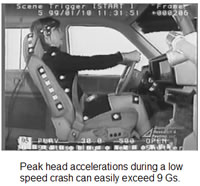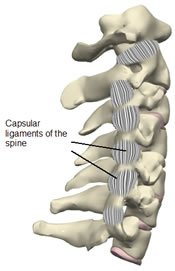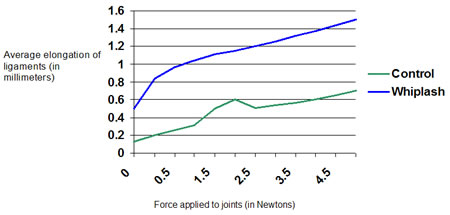Auto Injury, Auto Accident, Neck Injury
 It's difficult to describe the violence of a rear end collision, even one considered to be minor. Using live occupants in rear end crash tests, researchers have found head accelerations can easily reach 9 Gs of force, or nine times the force of gravity. What this means is that the human head—which weighs about 10 pounds, on average—suddenly weighs 90 pounds.
It's difficult to describe the violence of a rear end collision, even one considered to be minor. Using live occupants in rear end crash tests, researchers have found head accelerations can easily reach 9 Gs of force, or nine times the force of gravity. What this means is that the human head—which weighs about 10 pounds, on average—suddenly weighs 90 pounds.
In its most simple form, whiplash is this: the occupant's torso is accelerated in one direction, while the head is going in the opposite direction. In between the head and the torso is the neck, and it's not surprising that most of the injury takes place in the ligaments that hold the vertebrae together.
In fact, the forces on the ligaments of the spine are very high. Ivancic and colleagues1 at Yale University looked specifically at this issue. They found that during a simulated collision, the force in the lower portion of the neck reached 269.5 Newtons, or about 60 pounds of force, in about 1/20 of a second.
The fact is this: the human spine is not built to handle such strains, especially when they are focused on such a small area.
 Numerous studies have found that these forces far exceed the normal physiological range of the ligaments that hold the spine together. A new study2 by the same Yale researchers has looked more closely at the effects of whiplash on the spinal ligaments.
Numerous studies have found that these forces far exceed the normal physiological range of the ligaments that hold the spine together. A new study2 by the same Yale researchers has looked more closely at the effects of whiplash on the spinal ligaments.
The researchers started with 12 cadaver spines: six of them were exposed to simulated whiplash acceleration, and six were used as controls. The individual facet joints were then removed from the spines and tested to see if there was a difference in laxity of the joints between the two groups.
The following graph shows the difference in joint stretch between the two groups. As we can see, the whiplash-exposed ligaments were dramatically weaker than the healthy ligaments.

The authors discuss the implications of weakened ligaments after a collision:
"Increased CL [capsular ligament] laxity in whiplash patients may be one component perpetuating chronic neck pain and clinical instability. As the CL contains both mechanoreceptive and nociceptive nerve endings, CL injury during whiplash causing increased laxity may potentially injure these structures causing inflammation and pain. Increased CL laxity may cause residual instability, altered loading patterns, and nerve tissue impingement. Partial injury of embedded CL mechanoreceptors due to subfailure stretching of CLs may potentially cause [result in] altered muscle response patterns, muscle spasm, repositioning errors, and altered neck range of motion."
- Ivancic PC, Panjabi MM, Shigeki I. Cervical Spine Loads and Intervertebral Motions During Whiplash. Traffic Injury Prevention 2006;7(4):389-399.
- Ivancic PC, Ito S, Tominaga Y, Rubin W, et al. Whiplash causes increased laxity of cervical capsular ligament. Journal of Clinical Biomechanics 2007;October 22.
